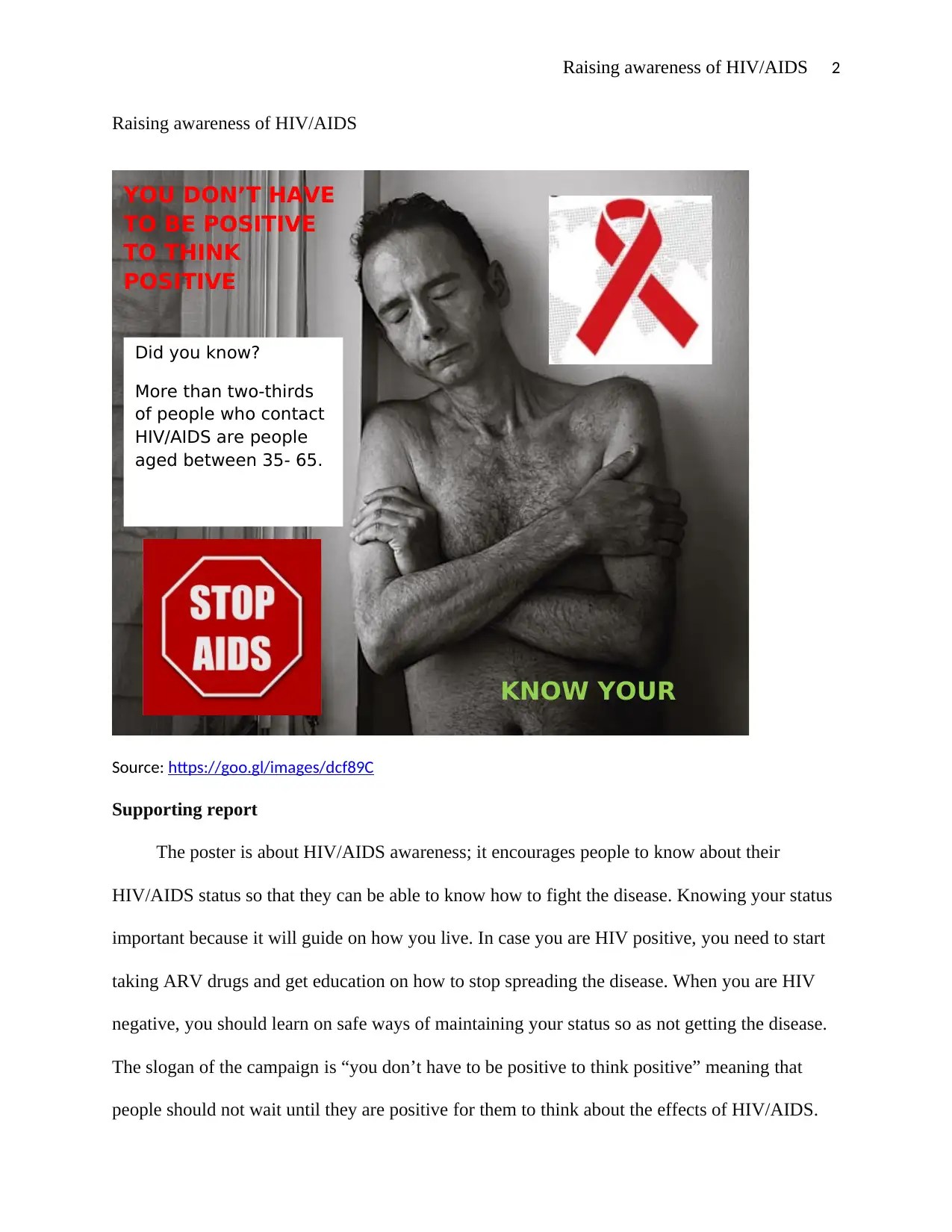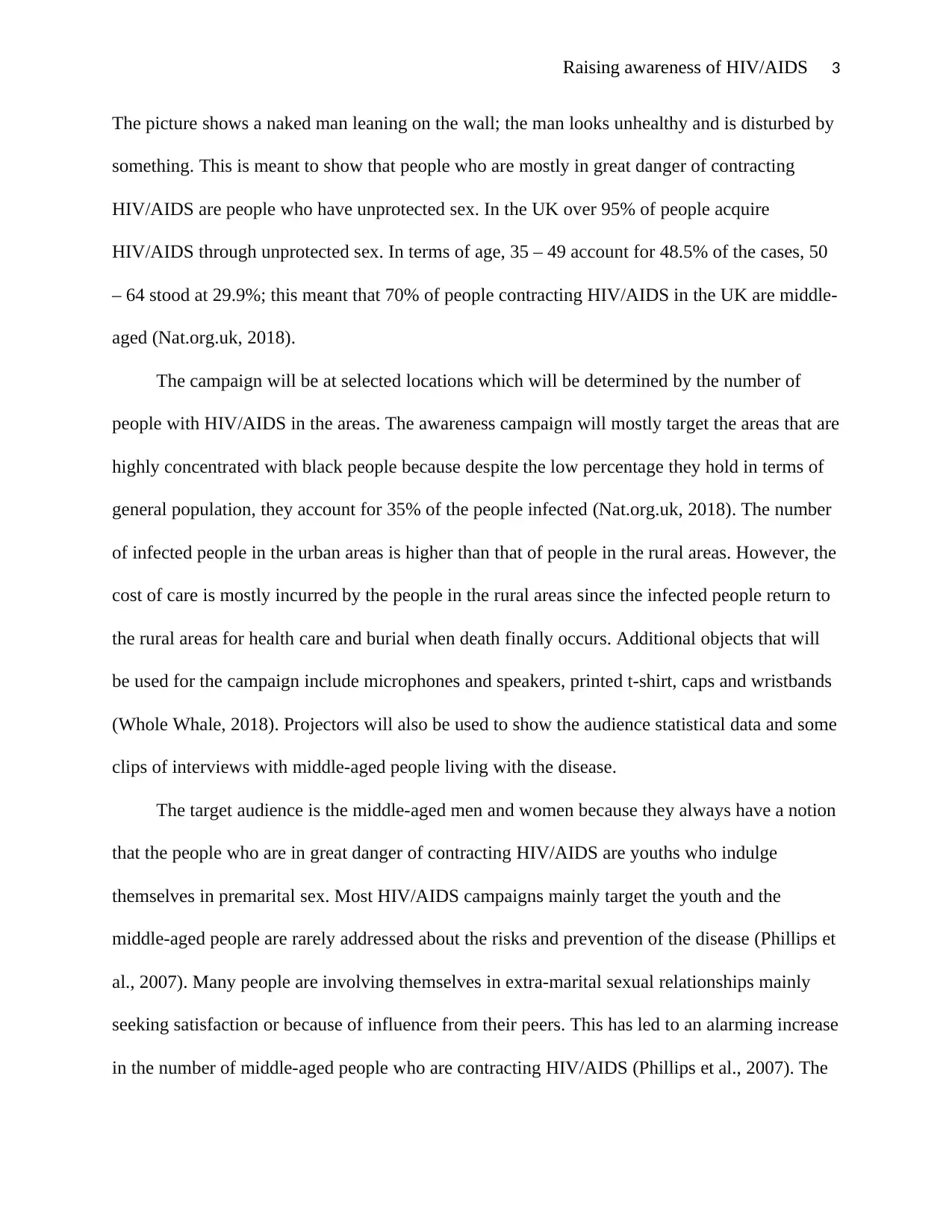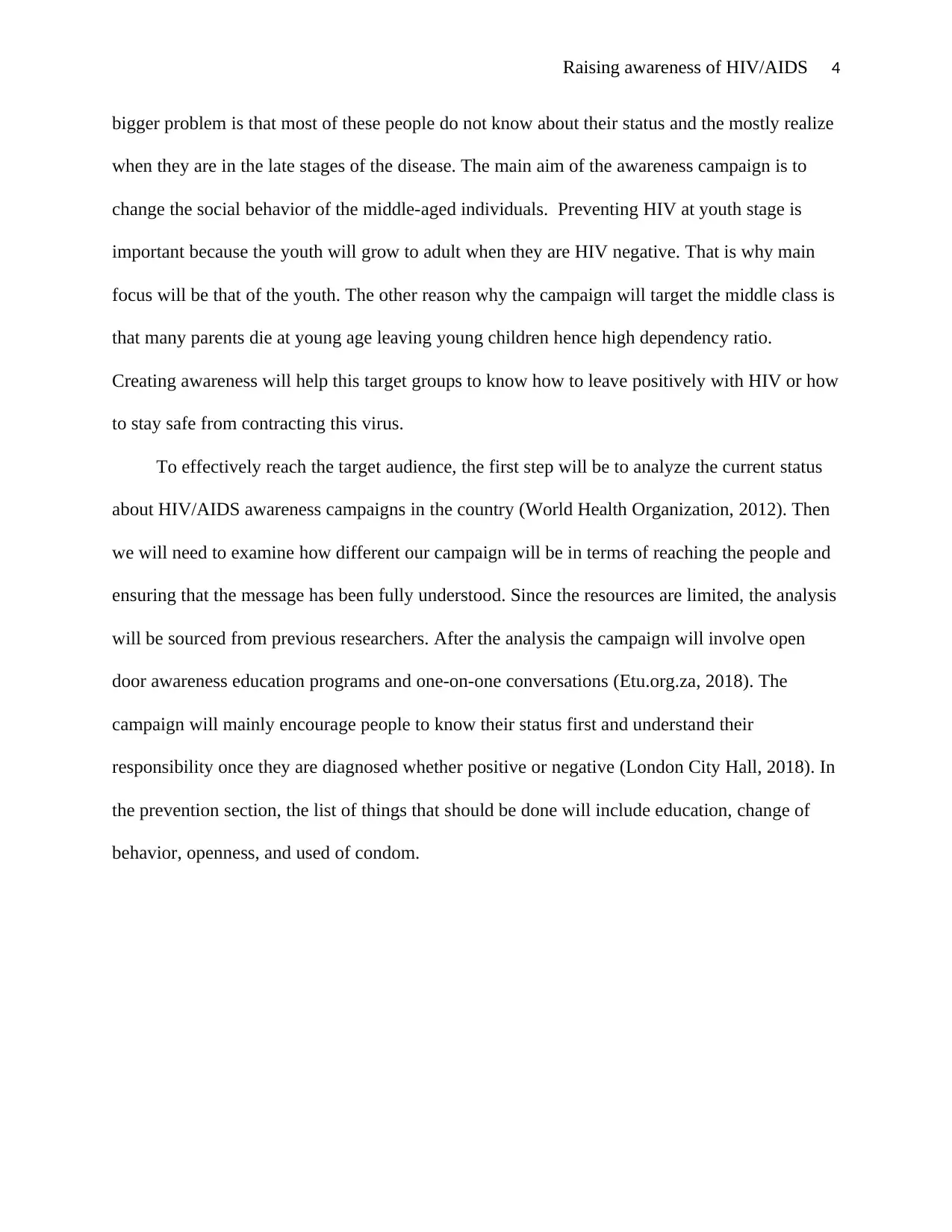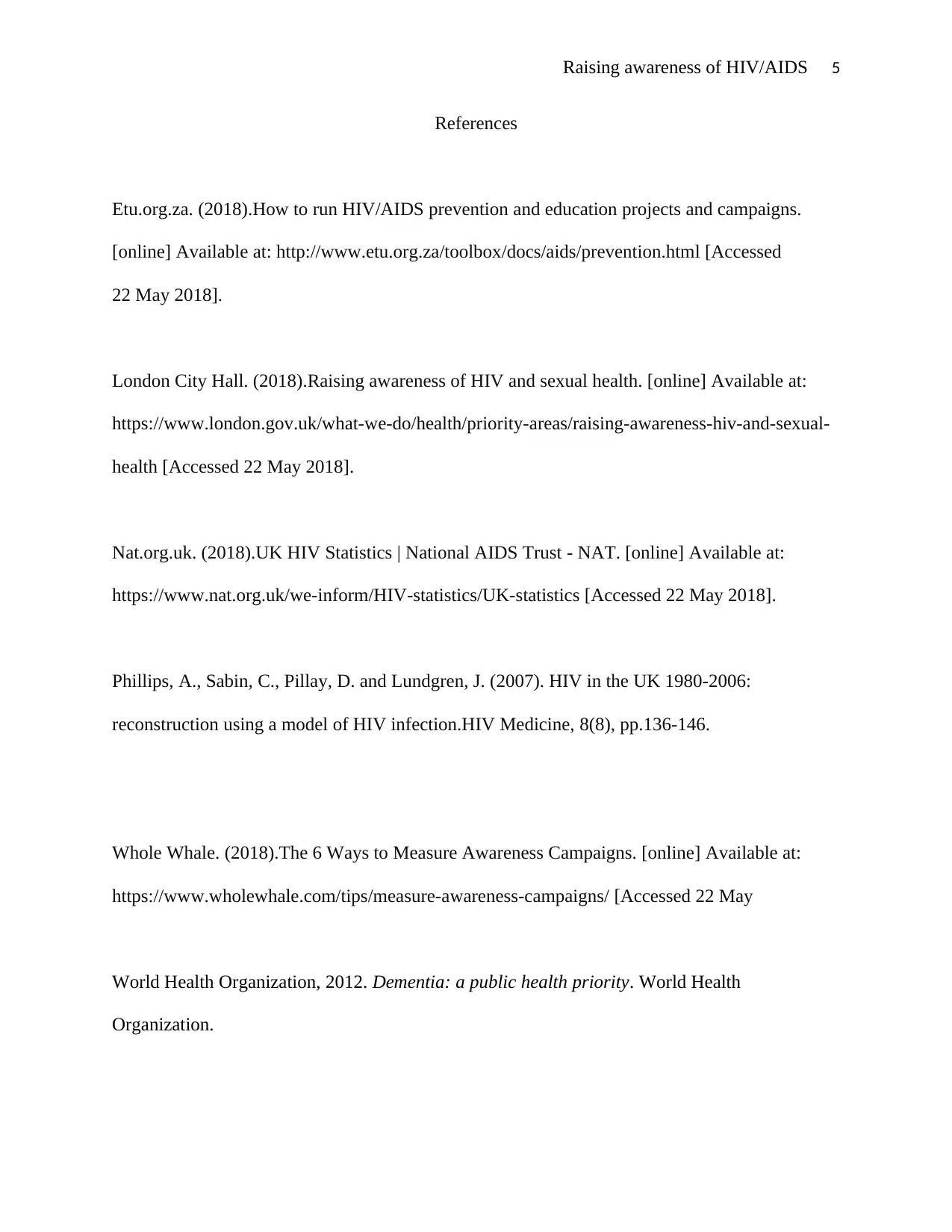HIV/AIDS Awareness: Campaign Strategies, Target Audience & Impact
VerifiedAdded on 2023/06/12
|6
|1075
|491
Report
AI Summary
This report focuses on raising awareness of HIV/AIDS, particularly among middle-aged adults, who are often overlooked in traditional awareness campaigns. It highlights the alarming increase in HIV/AIDS cases within this demographic due to factors like extra-marital relationships and a lack of awareness about their status. The report emphasizes the importance of knowing one's HIV/AIDS status, promoting safe sexual practices, and changing social behaviors to prevent further spread of the disease. Strategies include targeted campaigns in areas with high infection rates, utilizing various communication tools like posters, microphones, and projectors to disseminate information and statistical data. The ultimate goal is to encourage proactive thinking about HIV/AIDS prevention and to support those living with the disease to live positively and responsibly. Desklib provides past papers and solved assignments for students.

Raising awareness of HIV/AIDS 1
RAISING AWARENESS OF HIV/AIDS
By Name
Class (Course)
Instructor (Tutor)
Institution
The City and State
The Date
RAISING AWARENESS OF HIV/AIDS
By Name
Class (Course)
Instructor (Tutor)
Institution
The City and State
The Date
Paraphrase This Document
Need a fresh take? Get an instant paraphrase of this document with our AI Paraphraser

Raising awareness of HIV/AIDS 2
Raising awareness of HIV/AIDS
Source: https://goo.gl/images/dcf89C
Supporting report
The poster is about HIV/AIDS awareness; it encourages people to know about their
HIV/AIDS status so that they can be able to know how to fight the disease. Knowing your status
important because it will guide on how you live. In case you are HIV positive, you need to start
taking ARV drugs and get education on how to stop spreading the disease. When you are HIV
negative, you should learn on safe ways of maintaining your status so as not getting the disease.
The slogan of the campaign is “you don’t have to be positive to think positive” meaning that
people should not wait until they are positive for them to think about the effects of HIV/AIDS.
Did you know?
More than two-thirds
of people who contact
HIV/AIDS are people
aged between 35- 65.
YOU DON’T HAVE
TO BE POSITIVE
TO THINK
POSITIVE
KNOW YOUR
Raising awareness of HIV/AIDS
Source: https://goo.gl/images/dcf89C
Supporting report
The poster is about HIV/AIDS awareness; it encourages people to know about their
HIV/AIDS status so that they can be able to know how to fight the disease. Knowing your status
important because it will guide on how you live. In case you are HIV positive, you need to start
taking ARV drugs and get education on how to stop spreading the disease. When you are HIV
negative, you should learn on safe ways of maintaining your status so as not getting the disease.
The slogan of the campaign is “you don’t have to be positive to think positive” meaning that
people should not wait until they are positive for them to think about the effects of HIV/AIDS.
Did you know?
More than two-thirds
of people who contact
HIV/AIDS are people
aged between 35- 65.
YOU DON’T HAVE
TO BE POSITIVE
TO THINK
POSITIVE
KNOW YOUR

Raising awareness of HIV/AIDS 3
The picture shows a naked man leaning on the wall; the man looks unhealthy and is disturbed by
something. This is meant to show that people who are mostly in great danger of contracting
HIV/AIDS are people who have unprotected sex. In the UK over 95% of people acquire
HIV/AIDS through unprotected sex. In terms of age, 35 – 49 account for 48.5% of the cases, 50
– 64 stood at 29.9%; this meant that 70% of people contracting HIV/AIDS in the UK are middle-
aged (Nat.org.uk, 2018).
The campaign will be at selected locations which will be determined by the number of
people with HIV/AIDS in the areas. The awareness campaign will mostly target the areas that are
highly concentrated with black people because despite the low percentage they hold in terms of
general population, they account for 35% of the people infected (Nat.org.uk, 2018). The number
of infected people in the urban areas is higher than that of people in the rural areas. However, the
cost of care is mostly incurred by the people in the rural areas since the infected people return to
the rural areas for health care and burial when death finally occurs. Additional objects that will
be used for the campaign include microphones and speakers, printed t-shirt, caps and wristbands
(Whole Whale, 2018). Projectors will also be used to show the audience statistical data and some
clips of interviews with middle-aged people living with the disease.
The target audience is the middle-aged men and women because they always have a notion
that the people who are in great danger of contracting HIV/AIDS are youths who indulge
themselves in premarital sex. Most HIV/AIDS campaigns mainly target the youth and the
middle-aged people are rarely addressed about the risks and prevention of the disease (Phillips et
al., 2007). Many people are involving themselves in extra-marital sexual relationships mainly
seeking satisfaction or because of influence from their peers. This has led to an alarming increase
in the number of middle-aged people who are contracting HIV/AIDS (Phillips et al., 2007). The
The picture shows a naked man leaning on the wall; the man looks unhealthy and is disturbed by
something. This is meant to show that people who are mostly in great danger of contracting
HIV/AIDS are people who have unprotected sex. In the UK over 95% of people acquire
HIV/AIDS through unprotected sex. In terms of age, 35 – 49 account for 48.5% of the cases, 50
– 64 stood at 29.9%; this meant that 70% of people contracting HIV/AIDS in the UK are middle-
aged (Nat.org.uk, 2018).
The campaign will be at selected locations which will be determined by the number of
people with HIV/AIDS in the areas. The awareness campaign will mostly target the areas that are
highly concentrated with black people because despite the low percentage they hold in terms of
general population, they account for 35% of the people infected (Nat.org.uk, 2018). The number
of infected people in the urban areas is higher than that of people in the rural areas. However, the
cost of care is mostly incurred by the people in the rural areas since the infected people return to
the rural areas for health care and burial when death finally occurs. Additional objects that will
be used for the campaign include microphones and speakers, printed t-shirt, caps and wristbands
(Whole Whale, 2018). Projectors will also be used to show the audience statistical data and some
clips of interviews with middle-aged people living with the disease.
The target audience is the middle-aged men and women because they always have a notion
that the people who are in great danger of contracting HIV/AIDS are youths who indulge
themselves in premarital sex. Most HIV/AIDS campaigns mainly target the youth and the
middle-aged people are rarely addressed about the risks and prevention of the disease (Phillips et
al., 2007). Many people are involving themselves in extra-marital sexual relationships mainly
seeking satisfaction or because of influence from their peers. This has led to an alarming increase
in the number of middle-aged people who are contracting HIV/AIDS (Phillips et al., 2007). The
⊘ This is a preview!⊘
Do you want full access?
Subscribe today to unlock all pages.

Trusted by 1+ million students worldwide

Raising awareness of HIV/AIDS 4
bigger problem is that most of these people do not know about their status and the mostly realize
when they are in the late stages of the disease. The main aim of the awareness campaign is to
change the social behavior of the middle-aged individuals. Preventing HIV at youth stage is
important because the youth will grow to adult when they are HIV negative. That is why main
focus will be that of the youth. The other reason why the campaign will target the middle class is
that many parents die at young age leaving young children hence high dependency ratio.
Creating awareness will help this target groups to know how to leave positively with HIV or how
to stay safe from contracting this virus.
To effectively reach the target audience, the first step will be to analyze the current status
about HIV/AIDS awareness campaigns in the country (World Health Organization, 2012). Then
we will need to examine how different our campaign will be in terms of reaching the people and
ensuring that the message has been fully understood. Since the resources are limited, the analysis
will be sourced from previous researchers. After the analysis the campaign will involve open
door awareness education programs and one-on-one conversations (Etu.org.za, 2018). The
campaign will mainly encourage people to know their status first and understand their
responsibility once they are diagnosed whether positive or negative (London City Hall, 2018). In
the prevention section, the list of things that should be done will include education, change of
behavior, openness, and used of condom.
bigger problem is that most of these people do not know about their status and the mostly realize
when they are in the late stages of the disease. The main aim of the awareness campaign is to
change the social behavior of the middle-aged individuals. Preventing HIV at youth stage is
important because the youth will grow to adult when they are HIV negative. That is why main
focus will be that of the youth. The other reason why the campaign will target the middle class is
that many parents die at young age leaving young children hence high dependency ratio.
Creating awareness will help this target groups to know how to leave positively with HIV or how
to stay safe from contracting this virus.
To effectively reach the target audience, the first step will be to analyze the current status
about HIV/AIDS awareness campaigns in the country (World Health Organization, 2012). Then
we will need to examine how different our campaign will be in terms of reaching the people and
ensuring that the message has been fully understood. Since the resources are limited, the analysis
will be sourced from previous researchers. After the analysis the campaign will involve open
door awareness education programs and one-on-one conversations (Etu.org.za, 2018). The
campaign will mainly encourage people to know their status first and understand their
responsibility once they are diagnosed whether positive or negative (London City Hall, 2018). In
the prevention section, the list of things that should be done will include education, change of
behavior, openness, and used of condom.
Paraphrase This Document
Need a fresh take? Get an instant paraphrase of this document with our AI Paraphraser

Raising awareness of HIV/AIDS 5
References
Etu.org.za. (2018).How to run HIV/AIDS prevention and education projects and campaigns.
[online] Available at: http://www.etu.org.za/toolbox/docs/aids/prevention.html [Accessed
22 May 2018].
London City Hall. (2018).Raising awareness of HIV and sexual health. [online] Available at:
https://www.london.gov.uk/what-we-do/health/priority-areas/raising-awareness-hiv-and-sexual-
health [Accessed 22 May 2018].
Nat.org.uk. (2018).UK HIV Statistics | National AIDS Trust - NAT. [online] Available at:
https://www.nat.org.uk/we-inform/HIV-statistics/UK-statistics [Accessed 22 May 2018].
Phillips, A., Sabin, C., Pillay, D. and Lundgren, J. (2007). HIV in the UK 1980-2006:
reconstruction using a model of HIV infection.HIV Medicine, 8(8), pp.136-146.
Whole Whale. (2018).The 6 Ways to Measure Awareness Campaigns. [online] Available at:
https://www.wholewhale.com/tips/measure-awareness-campaigns/ [Accessed 22 May
World Health Organization, 2012. Dementia: a public health priority. World Health
Organization.
References
Etu.org.za. (2018).How to run HIV/AIDS prevention and education projects and campaigns.
[online] Available at: http://www.etu.org.za/toolbox/docs/aids/prevention.html [Accessed
22 May 2018].
London City Hall. (2018).Raising awareness of HIV and sexual health. [online] Available at:
https://www.london.gov.uk/what-we-do/health/priority-areas/raising-awareness-hiv-and-sexual-
health [Accessed 22 May 2018].
Nat.org.uk. (2018).UK HIV Statistics | National AIDS Trust - NAT. [online] Available at:
https://www.nat.org.uk/we-inform/HIV-statistics/UK-statistics [Accessed 22 May 2018].
Phillips, A., Sabin, C., Pillay, D. and Lundgren, J. (2007). HIV in the UK 1980-2006:
reconstruction using a model of HIV infection.HIV Medicine, 8(8), pp.136-146.
Whole Whale. (2018).The 6 Ways to Measure Awareness Campaigns. [online] Available at:
https://www.wholewhale.com/tips/measure-awareness-campaigns/ [Accessed 22 May
World Health Organization, 2012. Dementia: a public health priority. World Health
Organization.

Raising awareness of HIV/AIDS 6
⊘ This is a preview!⊘
Do you want full access?
Subscribe today to unlock all pages.

Trusted by 1+ million students worldwide
1 out of 6
Related Documents
Your All-in-One AI-Powered Toolkit for Academic Success.
+13062052269
info@desklib.com
Available 24*7 on WhatsApp / Email
![[object Object]](/_next/static/media/star-bottom.7253800d.svg)
Unlock your academic potential
Copyright © 2020–2025 A2Z Services. All Rights Reserved. Developed and managed by ZUCOL.





